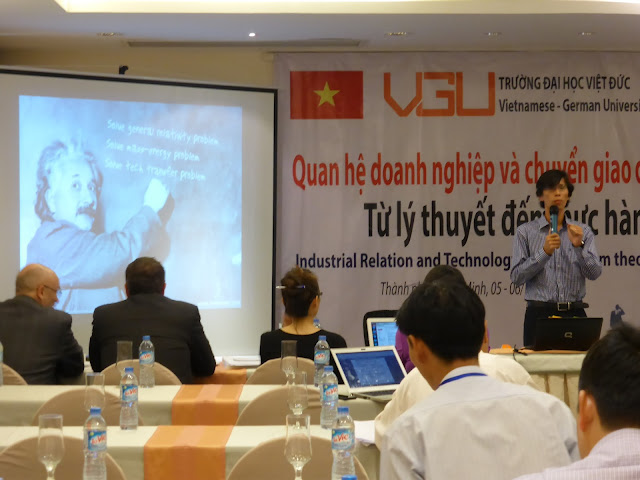"Funding Opportunities for Research and Academic Cooperation in Germany"
Dr. Annette Klosa, Head of DAAD Information Centre HCMC
www.daadvn.org/hcmc
Dr. Annette Klosa, Head of DAAD Information Centre HCMC
www.daadvn.org/hcmc
On Monday 14.12.2015, at SEAMEO Regional Training Center, HCMC, DAAD organized the seminar "Research in Germany" to introduce about the German research landscape in general as well as research opportunities at German universities and various scholarship programs.
Germany is home of 105 Nobel Laureates. Beside academic area, industry
also plays an important role in research. Three pillars of the German
research sector are universities (1), non-universities/research
institutes (2) and industrial research (3). There are good reasons for
studying or doing research in Germany, such as diverse range of study
and research opportunities, excellence in research and instruction,
close link between theory and practice, strong international focus and
diverse funding opportunities.
Source of Information
- Research in Germany: www.research-in-germany.org
- Funding Guide: www.funding-guide.de
- Doctoral Positions in Germany: www.phdgermany.de
- Jobs in Research and Higher Education: www.academics.com
- Euraxess Germany (support for mobile researchers): www.euraxess.de
Research organizations in Germany
- About 100 research universities, conducting research in all fields;
- 80 Max Planck Institutes: fundamental research in natural science and social science (to a lesser extent);
- 57 Fraunhofer Institutes: applied research in engineering science;
- 15 Helmholtz Institutes: pursuing long-term research goals of state and society;
- 84 Institutes in the Leibniz Association: both fundamental and applied researches.
Funding sources for research and researchers
- German Research Foundation (DFG): Largest research funding organisation in Europe www.dfg.de
- Alexander von Humboldt Foundation: Non-profit foundation funded by the German federal government and dedicated to supporting international research cooperation www.avh.de
- German Academic Exchange Service (DAAD): Independent organisation of German institutions of higher education, funded by the German federal Government and dedicated to world-wide academic cooperation www.daad.de
TU9 is the alliance of leading institutes (research universities) of
Technology in Germany. They stand for excellent research and teaching in
engineering and natural sciences.
RWTH Aachen
TU Berlin
TU Braunschweig
TU Darmstadt
TU Dresden
Leibniz Universität Hannover
Karlsruhe Institute of Technology (KIT)
TU München
Universität Stuttgart
TU Berlin
TU Braunschweig
TU Darmstadt
TU Dresden
Leibniz Universität Hannover
Karlsruhe Institute of Technology (KIT)
TU München
Universität Stuttgart
www.tu9.de
"German Research at a Glance"
Dr. Katja Lasch, Director International Research Marketing DAAD Bonn
"Research and Education in Germany - Experiences of a Humboldt Fellow"
Dr. Ta Thi Hoai An, Institute of Mathematics, Hanoi
Dr. Ta Thi Hoai An, Institute of Mathematics, Hanoi
"Research at University of Freiburg"
Dr. Rainer Giersiepen
Dr. Rainer Giersiepen
"Research at Vietnamese - German University"
Dr. Nguyen Le Hung, Vice President of VGU
Dr. Nguyen Le Hung, Vice President of VGU


















































































